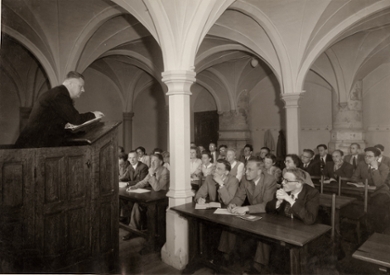
Pussy Riot and other stories about the Academy Building
In her book Rap 73, Dorrit van Dalen shares intimate anecdotes and what for many are previously unknown stories about the Academy Building and its users. Stories such as who held heated debates in the beautiful vaulted Gewelfkamer, and why the singer of the Russian punk band Pussy Riot was given pride of place in the staircase tower.
In 1581, following the eviction of the White Nuns, the former convent became home to the very newly established University of Leiden. There were two fires (in 1569 and 1616) and the building has been renovated several times, but the ancient layers of the building are still there, and its history lies ready and waiting. With love for this iconic building, author Dorrit van Dalen tells the stories of its various users down through the centuries, using exceptional photos, technical drawings and prints. Here is a preview of three remarkable examples from the book.
The metamorphoses of the Gewelfkamer
The Gewelfkamer (vaulted room), next to the Grand Auditorium, served as the university library from 1581, but it proved to be too damp for the books, and shortly afterwards, in 1593, the library moved to the University Chapel, the Faliede Bagijnkerk on the Rapenburg. The Gewelfkamer became home to the artes liberales, the introductory subjects that included rhetoric and grammar. Here, students debated their theses and the nature of science. Orthodox scholars and students fundamentally opposed followers of Descartes, who considered experimental research to be the foundation of science. In the late 17th century, debates here became so heated and disruptive that some professors resigned in protest.

New purposes for the building
For almost four centuries, the Gewelfkamer was the place where lectures and debates took place, until 1982, when the Faculty of Humanities was moved to the Witte Singel Doelen Complex. The Gewelfkamer was subsequently used as an exhibition area for the University’s Academic Historical Museum; these days its serves a somewhat less poetic purpose, as a cloakroom!

The observatory in the Academy Building
From 1632 to 1864, there was an observatory on the roof of the Academy Building. It was the initiative of Jacob Golius, Professor of Mathematics, astronomer and Arabist. He had a tower built on the roof with a dome that had 14 flaps facing in all directions. Students could observe the stars here using various instruments including a telescope on the quadrant. During the 18th century, the equipment began to age and the observatory was demolished. In its place came a new observation post with a rotating roof, which critics thought looked cluttered.
A collection of dovecotes
In his work Camera Obscura, Nicolaas Beets described the construction as a ‘collection of dovecots’, which he felt served little better than the naked eye. After years of lobbying by astronomer Friedrich Kaiser, a new observatory was built in the grounds of the Hortus Botanicus, and the dovecots were removed from the roof in 1864.

Pussy Riot in the staircase tower
As you climb the creaking stairs of the Academy Building’s oak staircase, you realise that the sounds of a building contribute to its character. The twelve-sided staircase tower was built straight after the fire in 1616. On the wall alongside the stairs is the Gradus ad Parnassum, a series of charcoal drawings depicting the temptations to which students are exposed. The drawings were made in secret by law student Victor de Stuers, who, without anyone knowing, allowed himself to get locked in the Academy Building one Sunday in 1865. Much less well known is the fact that many years later, De Stuers refused to have his vulnerable drawings restored.
Modern counterpart
Very few visitors know what can be seen in the section of the staircase tower that leads to the second floor. In 2020, artist Adam Uriel completed a modern counterpart to Stuers’ drawings; four scenes tell the story of a foreign student embarking on her studies in Leiden. The last scene shows two women who symbolise the universal desire for freedom. The woman with the guitar represents the lead singer of Russian punk band Pussy Riot; this woman is fighting for greater freedom under the oppressive Russian regime. The body of the other, naked, woman bears the words Bastion of Liberty. The artist is referring to Aliaa Elmahdy, an Egyptian woman who tweeted a nude photo of herself in protest against the regime in her country, which goes to show that current affairs can still penetrate the centuries-old walls of the University.
Text: Linda van Putten
